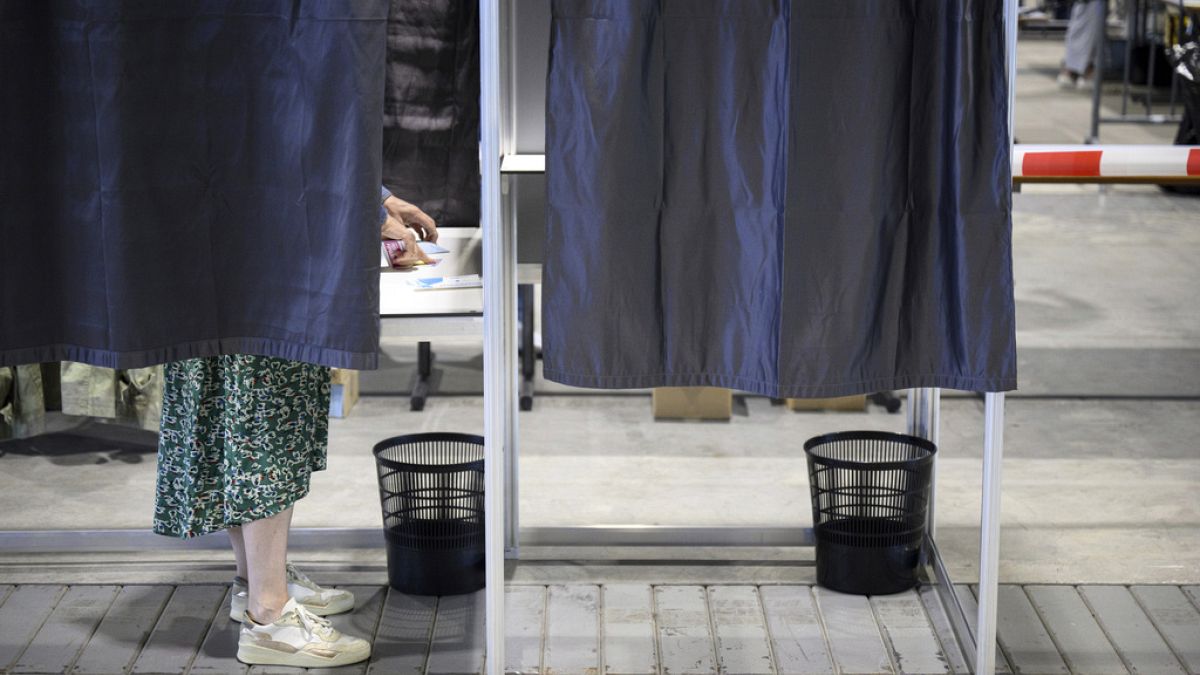World
States and families wrestle over compassion in transgender youth care bans in Tennessee, Kentucky

Questions over which side was being more compassionate emerged as a key fault line in a federal appeals court Friday, as judges heard arguments on whether to block transgender youth from receiving gender-affirming care in Kentucky and Tennessee.
Supporters of trans kids being able to get puberty blockers and hormone therapy argued that it is safe, necessary health care that’s backed by every major medical group. Advocates of state-level bans on children seeking the care countered that these are experimental and life-altering procedures that young people shouldn’t be exposed to.
U.S. District Judge Amul Thapar said concern over the child’s well-being is the “nut of the case.”
“I feel like there’s compassion in both directions,” Thapar said. “It’s not crazy to say that there’s a compassionate component to the other side of this — that maybe this is the kind of thing people might regret if they do it at age 14, 15.”
Earlier this year, the Sixth U.S. Circuit Court of Appeals in Cincinnati reversed lower court decisions and allowed both Kentucky and Tennessee to move ahead with preventing transgender minors from accessing the care. The move sparked alarm among advocates, who countered that doing so would immediately harm transgender young people currently receiving gender-affirming care, as well as those who may need to access it in the future.
Yet attorneys representing Kentucky and Tennessee argued that since the U.S. Supreme Court has ruled states can prohibit abortion, states are free to regulate gender-affirming care procedures as they see fit.
Friday’s hearing, which was held over video, comes amid a flurry of rulings this week stemming from disputes over limits on transgender and LGBTQ+ rights across the country over new laws in Republican-led states.
“The states play a front line in the indispensable role in regulating the practice of medicine,” said Solicitor General Matthew Kuhn, representing the Kentucky attorney general’s office.
But lawyers for transgender youth and their families said the teenage years are exactly when gender-affirming care should be administered.
“The evidence in this record shows that withholding treatment of even up to until the age of 18, and allowing puberty to occur consistent with the sex identified at birth, is extraordinarily harmful to these children,” said Stephanie Schuster, an attorney for Kentucky families.
Elsewhere in the U.S., the Texas Supreme Court allowed a law against gender-affirming care for youth to take effect Friday, while a federal court on Thursday blocked enforcement of a Texas anti-drag law that performers fear could shut them down or put them in jail. A federal judge in Kansas on Thursday told the state to stop letting transgender people change their birth certificates so the documents reflect their gender identities. Canada this week updated its travel advisory to the U.S., warning members of the LGBTQ+ community that they could face barriers and risks in American states that have enacted laws that may affect them.
And in Florida, a federal judge on Friday rejected requests to make it easier for transgender adults and children in the state to access gender-affirming care, at least for now.
Tallahassee-based U.S. District Judge Robert Hinkle said he would not immediately block enforcement of provisions of a new state law that is resulting in transgender adults continuing to receive hormone treatments. He might reconsider, he said, if he is given more medical evidence about the harm of halting treatments.
Florida is one of 22 states to adopt a law in the last few years banning gender-affirming care for children, including Texas, where enforcement began on Friday. But unlike others, the one signed by Republican Gov. Ron DeSantis in May also has provisions aimed at care for transgender adults.
The law requires that they give consent to treatment in person and with a physician present. Advocates say that’s a problem because much of the care is prescribed by nurse practitioners and/or through telehealth – and that it’s too hard for many patients to get or get to in-person appointments with physicians.
Hinkle also heard arguments Friday on whether to certify a group of transgender people as a class that rulings in the case would cover. He said he was willing to do that, but only with a clear definition of the class. But he said the hold on enforcement of the law for the plaintiffs in the case would not extend to other minors in the class.
Hinkle noted that he has a trial scheduled to start Nov. 13 to determine whether the law is constitutional.
He told lawyers for Florida that there are some problems with the law. “It is fairly remarkable that the state of Florida would tell a 40-year-old trans woman who has a doctor who says ‘You can take estrogen and it will improve your life,’ and the state of Florida says, ‘No you can’t take that.’”
___
Mulvihill reported from Cherry Hill, New Jersey.

World
Cinematography Work at Camerimage Festival ‘Radically Different,’ Jury Members Say

Jurors at the EnergaCamerimage cinematography fest say the Golden Frog main competition films have been remarkably varied and inspiring in the event’s 32nd edition.
The 12 competing films “were radically different from each other,” said “Barbie” and “Killers of the Flower Moon” cinematographer Rodrigo Prieto, whose directorial debut, “Pedro Paramo,” is also screening at the fest. “I enjoyed that.”
The varied styles, approaches and storytellers, he added, defied easy categorization. “Happily, I didn’t notice trends, which I have noticed sometimes in the past in some festivals.”
Juror Anthony Dod Mantle, who won Golden Frogs in 2008 for his lensing of “Slumdog Millionaire” and in 2016 for “Snowden,” said, “I’ve been to this festival before and the overall collection of films and categories, I felt, was even wider. I feel slight absence of certain films from other ethnic backgrounds. They were different, these films, but they could be far more different.”
Greater diversity and inclusion in cinematography has justly been a hot topic this year at Camerimage, he added. “It’s good we embrace that, celebrate it here, because not many festivals do that.”
Dod Mantle described the current state of cinematography, based on what the jury’s seen this week, as “openly variable and that’s why we praise some films rather than others because they challenge convention.”
He also described the industry as “in a bit of a pickle,” adding, “We know that. We have to applaud ourselves and embrace and encourage every single essence of, molecule of, exploration and challenging cinema.”
Juror Lukasz Zal, who filmed “The Zone of Interest” and “Cold War,” said “I feel really inspired. I feel this kind of positive envy when you just see something which you admire, and love – cinema is still in good condition.”
And, he added, “I’m becoming hopeful that, OK, there’s still a lot to discover. For this, I really love Camerimage. When I was here, when I was a student, I was always coming back home after festival, with this feeling, kind of eager to work, to prepare and to just be really open and be full of ideas.”
Spending time here again as a top professional in his field, Zal said, “I feel again like a student.”
Juror Cate Blanchett said it’s clear cinematography has no crisis of creativity currently.
Instead, there’s a different issue: “The pickle is how one gets access and is able to see these films in the way that they’re intended to be seen.”
Technology advances in the field are also helping storytelling onscreen evolve, she added, rather than distracting from it. “Sometimes you can see there’s been huge technical advances made, or there’s been big innovations, and they haven’t yet been integrated into the stories that they’re being applied to. Whereas I thought there were so many films here that have really integrated the technology and in a completely adventurous and inventive way that was not pretentious. It was very interwoven and enmeshed with the performances and the stories.”
Jury duty at Camerimage is rewarding, said Dod Mantle, because the Golden Frog award can often help promising cinematographers break through to booming careers.
He described the potential effect of the award as “enormous.”
“The first time I came here, in competition,” he recalled, “it illustrated for me the jury was embracing cinema, celebrating something different and challenging.”
Cinematographers are keenly aware of the judgment of their peers, Dod Mantle added. “You feel quite vulnerable here. I’ve seen cinematographers leave the festival and go spend the weekend in Krakow and come back. The frog, ultimately is a beautiful thing celebrating our colleagues’ work.”
Juror Anna Higgs, a producer and columnist who works closely with BAFTA, said, “I think we should normalize cinematographers getting asked for their autographs – the fact that this frog is the idolized thing here.”
Blanchett added, “It’s very rare that you go to a festival where every single person in the auditorium sits right through the credit roll to the very end.” She noted “the respect that is shown to every single crewmember.”
Prieto recalled the impact of his own Golden Frog cinematography win in 2000 for “Amores Perros” fondly. “I do cherish that frog. It’s wonderful to get a frog, but more than anything, it’s a place where cinematography is the focus and is celebrated, and to share that obsession with so many people, and the energy of that, is really wonderful.”
Zal had a similar career boost, he said, after winning for lensing “Ida” by Pawel Pawlikowski in 2013. “That’s really the moment when somehow my career changed. I was always dreaming while having student films here. And it was beautiful to get an award from colleagues and being here and being among amazing cinematographers.
“I was put in competition with the people who I admire. Even now, sitting with Rodrigo, who for me was a huge inspiration. I was shooting my films in school inspired by ‘Amores Perros.’ Now we’re sitting together on the jury. That’s amazing, that’s beautiful.”
Blanchett described the close proximity of students and top international lensers as a unique strength of Camerimage, praising “the mentorship that goes on, how you’ll champion the works of other people.”
“I think that’s why it’s so vitally important that there’s an increased level of female participation. Because of the networking and mentorship opportunities and championing the work. The conversations and the opportunities that arise from those conversations are really important.”
Oscar-winning costume designer Sandy Powell (“Shakespeare in Love,” “The Aviator” and “The Young Victoria”) and cinematographer and documentary filmmaker Jolanta Dylewska also served on the Camerimage jury, calling earlier this week for greater diversity and inclusion in the industry.
World
Ukraine to analyze fragments of missile fired by Russia capable of carrying nuclear warheads

Investigators in Ukraine are analyzing the debris of a new intermediate-range ballistic missile (IRBM) fired by Russia at the city of Dnipro on Thursday, marking the first time the weapon had been used on the battlefield.
On Sunday, Ukraine’s Security Service showed the remaining fragments of the IRBM called Oreshnik – Russian for Hazel Tree – that struck a factory to The Associated Press.
Russian President Vladimir Putin confirmed the attack on Thursday evening in an address to the nation and said it was in direct response to the U.S. and the U.K. jointly approving Ukraine’s use of Western-supplied long-range missiles to target Russia.
The Pentagon has said the missile is based on Russia’s RS-26 Rubezh intercontinental ballistic missile (ICBM), though the wreckage has not yet been analyzed, according to security officials on site in an undisclosed location in Ukraine.
‘NEW’ RUSSIAN MISSILE USED AGAINST UKRAINE NOT HYPERSONIC, DEFENSE OFFICIALS SAY
Fragments of a rocket which struck Dnipro on November 21 are seen at a center for forensic analysis in undisclosed location, Ukraine, Sunday Nov. 24, 2024. (AP Photo/Evgeniy Maloletka)
The AP and other media were permitted to view the fragments before being taken over by investigators.
The wire service showed images of what it described as mangled and charred wires, along with an ashy airframe about the size of a large snow tire. The remains were all that were left of the IRBM, which can carry nuclear or conventional warheads.
“It should be noted that this is the first time that the remains of such a missile have been discovered on the territory of Ukraine,” a specialist with Ukraine’s Security Service said. The specialist only identified himself by his first name Oleh because he was not authorized to discuss the issue with the media.
1,000 DAYS OF WAR IN UKRAINE AS ZELENSKYY DOUBLES DOWN ON AERIAL OPTIONS WITH ATACMS, DRONES AND MISSILES

Fragments of a rocket which struck Dnipro on November 21 are seen at a center for forensic analysis in undisclosed location, Ukraine, Sunday Nov. 24, 2024. (AP Photo/Evgeniy Maloletka)
Ukraine’s Main Intelligence Directorate said the missile was launched from the 4th Missile Test Range, Kapustin Yar, in Russia’s Astrakhan region. Once launched, Ukrainian officials said, it flew for 15 minutes before striking Dnipro. The missile was carrying six warheads, each carrying six subunitions, and its speed was Mach 11.
Last week, Deputy Pentagon press secretary Sabrina Singh confirmed to reporters during a press briefing that Russia had launched the IRBM, noting that it was a “new type of lethal capability that was employed on the battlefield.”
She also said the U.S. was notified briefly before the launch through nuclear or risk reduction channels.
US EMBASSY IN KYIV CLOSED AS ‘POTENTIAL SIGNIFICANT AIR ATTACK’ LOOMS

Fragments of a rocket which struck Dnipro on November 21 are seen at a center for forensic analysis in undisclosed location, Ukraine, Sunday Nov. 24, 2024. (AP Photo/Evgeniy Maloletka)
Putin also said last week that the missile attacked targets at a speed of Mach 10.
Despite Ukraine’s and Putin’s claim that the rocket reached speeds greater than Mach 10, two U.S. defense officials told Fox News on Thursday the missile was not hypersonic, which, according to NASA, is a speed greater than 3,000 mph and faster than Mach 5.
Along with launching the IRBM for the first time on the battlefield, Putin signed a law to grant debt forgiveness to those who enlist in Russia’s army to fight in Ukraine.
US BRIEFED UKRAINE AHEAD OF PUTIN’S ‘EXPERIMENTAL INTERMEDIATE-RANGE BALLISTIC’ ATTACK

Fragments of a rocket which struck Dnipro on November 21 are seen at a center for forensic analysis in undisclosed location, Ukraine, Sunday Nov. 24, 2024. (AP Photo/Evgeniy Maloletka)
The AP reported that the measure highlights the country’s need for military personnel as it continues its war against Ukraine.
Russian state news agency Interfax said the new legislation allows new recruits enlisting for a one-year contract, to write off debts up to 10 million rubles, or about $96,000.
CLICK TO GET THE FOX NEWS APP
The law reportedly applies to debts in which a court order for collection was issued, and enforcement proceedings had commenced before Dec. 1, 2024. The legislation also applies to spouses of new recruits.
The Associated Press contributed to this report.
World
Voters in Switzerland say no to bigger motorways

The federal government argues that the volume of traffic on the motorway network has increased more than five times over the past sixty years.
Swiss voters took to the polls on Sunday to vote no to bigger motorways, no to easier evictions and tighter subletting rules and yes to a new healthcare financing model.
The Swiss government’s proposal to allocate €5.3 million for expanding motorways and constructing new roads at six key locations, including near Bern and between Geneva and Lausanne, was rejected by 52.7% of voters.
The plan, approved by parliament last year, faced opposition from those concerned about its environmental impact and effectiveness.
The federal government, argues that the volume of traffic on the motorway network has increased more than five times over the past 60 years.
The result was celebrated by the Green Party which called the proposal “an out-of-date transport policy”.
Together with left-wing and environmental groups, the Greens campaigned against the project, highlighting its environmental impact and the concern that wider roads would only lead to more traffic. They now advocate for the funds to be used for public transport, active mobility, and the renovation of existing motorways.
Mattea Meyer from the no camp expressed her satisfaction with the referendum result.
“I am incredibly pleased that a majority of the population does not want a highway expansion, and instead wants more climate protection, a transport transition that is climate-compatible, which the highway expansion is not,” she said.
According to local media to counter this decision the yes campaign, plans on moving forward with expansion projects separately through agglomeration programs, reducing the chance for cantonal referendums.
No to easier evictions
On Sunday, Swiss voters decided on multiple housing issues, such as subletting and lease termination.
53.8% of them rejected the proposal which would make it easier for landlords to terminate leases early in order to use properties for their own purposes.
Additionally, 51.6% voted against a plan for stricter regulations on subletting residential and commercial properties. According to local media, these issues attracted significant attention because tenancy laws affect the majority of Swiss citizens, with about 60% of the population renting their homes, the highest rate in Europe.
The proposal to ease eviction rules faced strong opposition, especially in French-speaking cantons, with Geneva seeing 67.8% of its voters against the plan due to the city’s ongoing housing shortage.
-

 Business1 week ago
Business1 week agoColumn: Molly White's message for journalists going freelance — be ready for the pitfalls
-

 Science5 days ago
Science5 days agoTrump nominates Dr. Oz to head Medicare and Medicaid and help take on 'illness industrial complex'
-

 Politics7 days ago
Politics7 days agoTrump taps FCC member Brendan Carr to lead agency: 'Warrior for Free Speech'
-
/cdn.vox-cdn.com/uploads/chorus_asset/file/25739950/247386_Elon_Musk_Open_AI_CVirginia.jpg)
/cdn.vox-cdn.com/uploads/chorus_asset/file/25739950/247386_Elon_Musk_Open_AI_CVirginia.jpg) Technology6 days ago
Technology6 days agoInside Elon Musk’s messy breakup with OpenAI
-

 Lifestyle1 week ago
Lifestyle1 week agoSome in the U.S. farm industry are alarmed by Trump's embrace of RFK Jr. and tariffs
-

 World7 days ago
World7 days agoProtesters in Slovakia rally against Robert Fico’s populist government
-

 News7 days ago
News7 days agoThey disagree about a lot, but these singers figure out how to stay in harmony
-

 News7 days ago
News7 days agoGaetz-gate: Navigating the President-elect's most baffling Cabinet pick



















